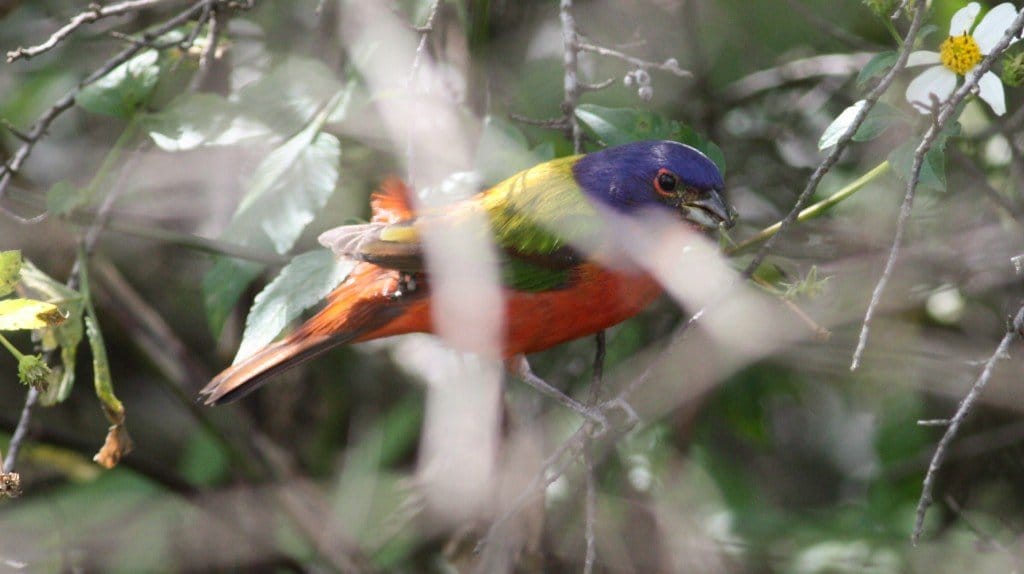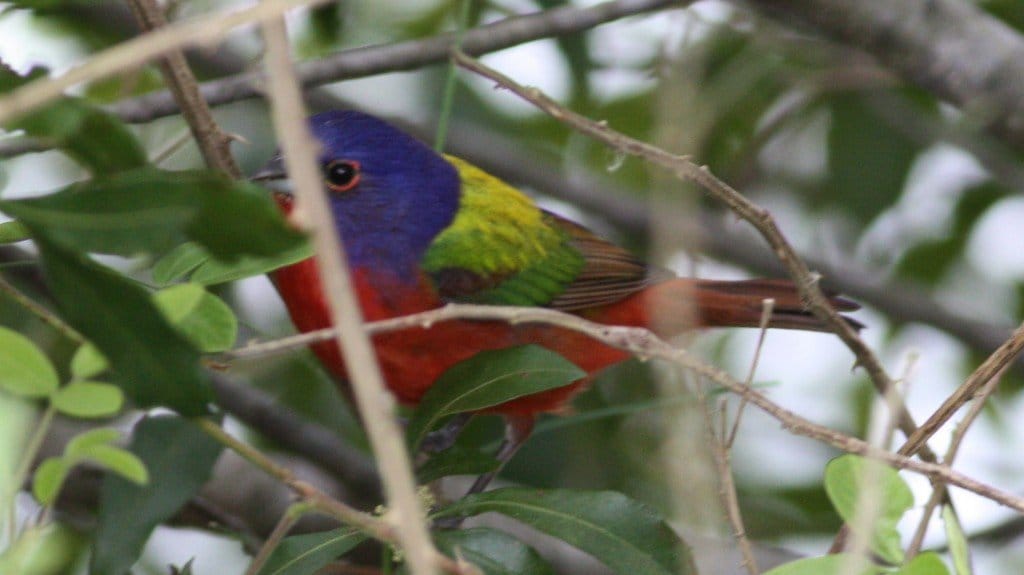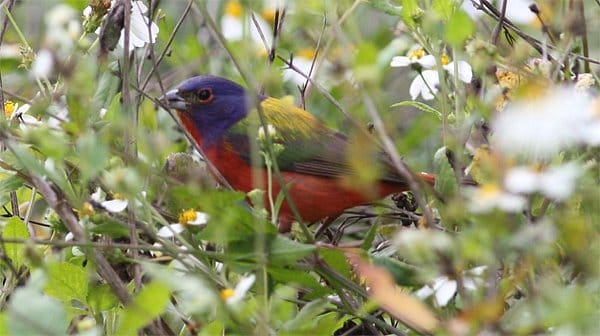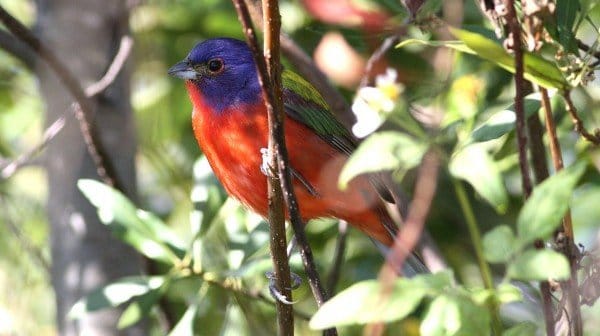I was in Florida last week, the freakiest of the southeastern states. Its peninsular shape, dipping so seductively into the neotropic Caribbean, suggest a haul of bizarre and fascinating birds found nowhere else on the continent. All true of course. But not only is Florida’s native birdlife pretty amazing, it also hosts strange exotics; species brought here accidentally and on purpose that for one reason or another managed to break free of the bonds of captivity and make a new life on foreign shores, with a more or less detrimental impact on the indigenous species (isn’t that always the way it is?).
This uneasy non-truce, however, means that birders have it pretty good down there, and there’s probably no place on the planet that’s more akin to a free-flying aviary than the Sunshine State. It goes without saying that one can rack up a pretty decent day’s birding without working too hard at it, which is precisely what I found myself doing as I was stuck at a resort in the Orlando area with limited access to a car. I don’t play golf and I’m not one for laying out by the pool so my Florida related activities are almost exclusively exploration related and even though I was hardly at what you’d call a wildlife refuge, it was Florida. You takes what you gets.
So I spent a lot of time wandering up and down a walking path that meandered past a few artificial lakes filled with the usual assortment of fancy wading birds and wintering Coots. It was along one of these little ponds that I found the most productive stretch of brush in the whole of my little developed corner of Orange County, Florida. It was consistently packed with Palm and Yellow-rumped Warblers, Gray Catbirds, a single Common Ground-Dove, and quite possible the most beautiful bird in Florida (and that includes exotics) a male Painted Bunting.
I was packing heat, my new 400mm lens. This was the moment I had been waiting for. And it was was here, standing in the sun while increasingly incredulous onlookers passed me by, that I realized that having a wonderful bird and a wonderful lens do not necessarily a wonderful photo make. To whit…

For such a stunning and awe-inducing bird, it did everything it possibly could to stay in the densest portion of this little hedgerow. This made any sort of lingering look – and those are really the sort you want when dealing with a Painted Bunting – not to mention any attempt at photography, nearly impossible. Even a little pishing sent the Palm Warblers into fits, buzzing around my head like cartoon stars following a traumatic head injury, but this amazing patchwork bird stayed obscured by the blackberry brambles in which it preferred to implant itself.
Maybe this time?

Guh.
I noted that the bird itself was working in a particular direction, and got ahead of it. Carefully navigating the impressive fire ant hill, I plopped myself down on the sidewalk. I waited. I had nothing better to do, after all. And slowly, slowly, it came to me, pausing on the edge of the higher grasses and nibbling at seeds.

Until finally, at long last, it perched out in the open – in the sun, even – and I was able to really enjoy this Painted Bunting, one of the southeast’s, and arguably North America’s, most beautiful birds.

Patience pays off and Florida delivers again, even in the most unexpected places.











Stunning bird and great story, thanks for sharing the moment.
I have had more than my share of this type of experience however the birds always seem to head off in the opposite direction when I set up and wait…
One other thing is that the birds always seem to be better in the next state or town or district or country……
Nate, every time we’ve visited the Disney area, I’ve looked for this bird. Never seen one there. Seen feral pigs, difficult grebes, an armadillo, egrets, etc. But never a Painted Bunting, a bird that I thought must’ve been a printer’s mistake when I first came across it as a kid in my beginners’ bird book. You’re lucky twice: to have seen it and to have photographed it perfectly. Thanks for sharing the story and pictures.
@Gareth- Thanks much! It was easily the best experience I’ve had with a Painted Bunting.
@Mike- Thanks! Honestly, it was a bird that was completely off my radar, which made the discovery all the better.
Nate, please only post birds like Painted Bunting once our European Acrocephalus warblers have returned. How am I supposed to re-gain my inner balance if I cannot quickly rush outside to take in a good portion of different shades of brown? 🙂
Good bird. And probably the only bird I am glad I missed. When I was in and around St. Louis, one was staying in the general area and I had even driven by it by a mere 20 yards, as I found out later on a St. Louis list serve. I even remember that patch of habitat, because as I was driving by I thought to myself that maybe I should go check it quickly. I didn’t and thus missed the Painted Bunting (which would have been a lifer). however, the bird there was a female, and I’d really, really like my lifer Painted Bunting to be a male.
Man, the new 400m is working out nicely! Even the images with those pesky twigs in the way look good! Such an incredibly gorgeous bird species.
Hey Nate, great catch. You got that on just one individual? I can go out and see a number of them in a day and never get that good of a view or that nice of a specimen. Congratulations to a good story teller and aspiring photographer!
Great story and nice shots, Nate! Loved this! Thanks for posting!
We enjoyed a very brave bunting pair for 4-6 weeks in June and July. The male would come to the feeder near our kitchen window and hang around to pose for pictures most days. We are in the country west of Austin Texas. Probably in mid July they migrated south. Or they may be hiding in the thickets as described.
Thanks for the commentary and the photos. We saw them for the first time yesterday in Okeeheelee park in Palm Beach County. Coming from Mass, this was such a treat!
February 12th at 5:30 p.m.
I was just finishing some yard work late this afternoon and I saw a painted bunting in my backyard in West Palm Beach. I crouched down and stayed real still and watched it while it pecked around the grass for quite a while. Finally it saw me and flew over to some plants and stayed there looking for something to eat. I was so excited to see such a beautiful bird. I have rarely seen them.